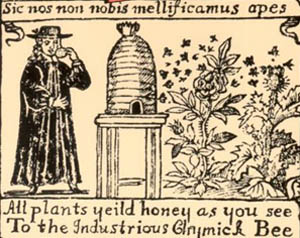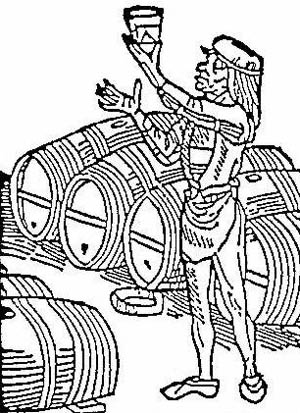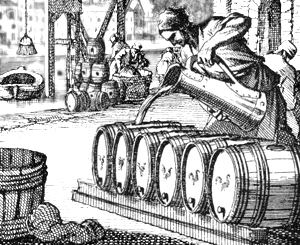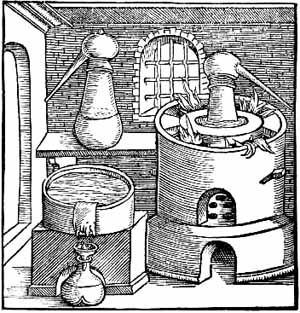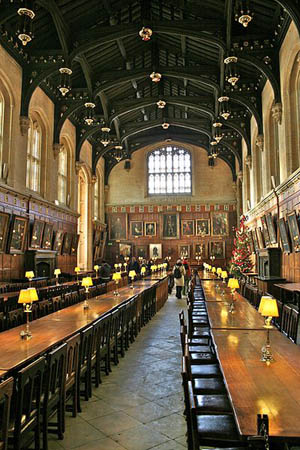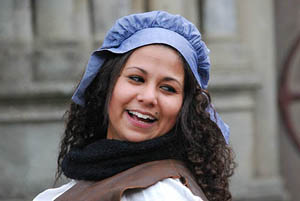Life In A Medieval Castle
|
|
|
||||||||||||||||||
Medieval Drinks
In the Middle Ages, however, concerns over purity, medical recommendations and its low prestige of water made it less favored. Alcoholic beverages were always preferred. They were seen as more nutritious and beneficial to digestion than water, with the invaluable bonus of being less prone to putrefaction due to the alcohol content. Wine was consumed on a daily basis in most of France and all over the Western Mediterranean wherever grapes were cultivated. Further north it remained the preferred drink of the bourgeoisie and the nobility who could afford it, and far less common among peasants and workers. The drink of commoners in the northern parts of the continent was primarily beer or ale. Because of the difficulty of preserving this beverage for any time (especially before the introduction of hops), it was mostly consumed fresh; it was therefore cloudier and perhaps had a lower alcohol content than the typical modern equivalent. Plain milk was not consumed by adults except the poor or sick, being reserved for the very young or elderly, and then usually as buttermilk or whey. Fresh milk was overall less common than other dairy products because of the lack of technology to keep it from spoiling. Juices, as well as wines, of a multitude of fruits and berries had been known at least since Roman antiquity and were still consumed in the Middle Ages: pomegranate, mulberry and blackberry wines, perry, and cider which was especially popular in the north where both apples and pears were plentiful. Medieval drinks that have survived to this day include prunellé from wild plums (modern-day slivovitz), mulberry gin and blackberry wine. Many variants of mead have been found in medieval recipes, with or without alcoholic content. However, the honey-based drink became less common as a table beverage towards the end of the period and was eventually relegated to medicinal use.
|
|
|||||||||||||||||
Wine
Wine was commonly drunk and was also regarded as the most prestigious and healthy choice. According to Galen's dietetics it was considered hot and dry but these qualities were moderated when wine was watered down. Unlike water or beer, which were considered cold and moist, consumption of wine in moderation (especially red wine) was, among other things, believed to aid digestion, generate good blood and brighten the mood. The quality of wine differed considerably according to vintage, the type of grape and more importantly, the number of grape pressings. The first pressing was made into the finest and most expensive wines which were reserved for the upper classes. The second and third pressings were subsequently of lower quality and alcohol content. Common folk usually had to settle for a cheap white or rosé from a second or even third pressing, meaning that it could be consumed in quite generous amounts without leading to heavy intoxication. For the poorest, watered-down vinegar would often be the only available choice.
Even if vinegar was a common ingredient, there was only so much of it that could be used. In the 14th century cookbook Le Viandier there are several methods for salvaging spoiling wine; making sure that the wine barrels are always topped up or adding a mixture of dried and boiled white grape seeds with the ash of dried and burnt lees of white wine were both effective bactericides, even if the chemical processes were not understood at the time.[ Spiced or mulled wine was not only popular among the affluent, but was also considered especially healthy by physicians. Wine was believed to act as a kind of vaporizer and conduit of other foodstuffs to every part of the body, and the addition of fragrant and exotic spices would make it even more wholesome. Spiced wines were usually made by mixing an ordinary (red) wine with an assortment of spices such as ginger, cardamom, pepper, grains of paradise, nutmeg, cloves and sugar. These would be contained in small bags which were either steeped in wine or had liquid poured over them to produce hypocras and claré. By the 14th century, bagged spice mixes could be bought ready-made from spice merchants. |
|
|||||||||||||||||
|
|
||||||||||||||||||
Mead
Mead or honey wine is an alcoholic beverage, made from honey and water via fermentation with yeast. Its alcoholic content may range from that of a mild ale to that of a strong wine. It may be still, carbonated, or sparkling; it may be dry, semi-sweet, or sweet. Depending on local traditions and specific recipes, it may be brewed with spices, fruits, or grain mash. It may be produced by fermentation of honey with grain mash; mead may also be flavoured with hops to produce a bitter, beer-like flavour. Mead is known from many sources of ancient history throughout Europe, Africa and Asia, although archaeological evidence of it is ambiguous. Around AD 550, the Brythonic speaking bard Taliesin wrote the Kanu y med or "Song of Mead." The legendary drinking, feasting and boasting of warriors in the mead hall is echoed in the mead hall Dyn Eidyn (modern day Edinburgh), and in the epic poem Y Gododdin, both dated around AD 700. In the Old English epic poem Beowulf, the Danish warriors drank Honey mead. Mead was the historical beverage par excellence and commonly brewed by the Germanic tribes in Northern Europe. Later, taxation and regulations governing the ingredients of alcoholic beverages led to commercial mead becoming a more obscure beverage until recently. Some monasteries kept up the old traditions of mead-making as a by-product of beekeeping, especially in areas where grapes could not be grown. Mead can have a wide range of flavors, depending on the source of the honey, additives (also known as "adjuncts" or "gruit"), including fruit and spices, the yeast employed during fermentation, and aging procedure. Mead can be difficult to find commercially. Some producers have marketed white wine with added honey as mead, often spelling it "meade." This is closer in style to a Hypocras. Blended varieties of mead may be known by either style represented. For instance, a mead made with cinnamon and apples may be referred to as either a cinnamon cyser or an apple metheglin. A mead that also contains spices (such as cloves, cinnamon or nutmeg), or herbs (such as oregano, hops, or even lavender or chamomile), is called a metheglin (pronounced A mead that contains fruit (such as raspberry, blackberry or strawberry) is called a melomel which was also used as a means of food preservation, keeping summer produce for the winter. A mead that is fermented with grape juice is called a pyment.[ Mulled mead is a popular drink at Christmas time, where mead is flavoured with spices (and sometimes various fruits) and warmed, traditionally by having a hot poker plunged into it. Some meads retain some measure of the sweetness of the original honey, and some may even be considered as dessert wines. Drier meads are also available, and some producers offer sparkling meads. There are a number of faux-meads, which are actually cheap wines with large amounts of honey added, to produce a cloyingly sweet liqueur.[citation needed] Historically, meads were fermented by wild yeasts and bacteria residing on the skins of the fruit or within the honey itself. Wild yeasts generally provide inconsistent results, and in modern times various brewing interests have isolated the strains now in use. Certain strains have gradually become associated with certain styles of mead. Mostly, these are strains that are also used in beer or wine production. Commercial labs have developed yeast strains specifically for mead. Mead can be distilled to a brandy or liqueur strength. A version of this called "honey jack" can be made by partly freezing a quantity of mead and pouring off the liquid without the ice crystals (a process known as freeze distillation), in the same way that applejack is made from cider. |
|
|||||||||||||||||
|
|
||||||||||||||||||
Beer
While wine was the most common table beverage in much of Europe, this was not the case in the northern regions where grapes were not cultivated. Those who could afford it drank imported wine, but even for nobility in these areas it was common to drink beer or ale, particularly towards the end of the Middle Ages. In England, the Low Countries, northern Germany, Poland and Scandinavia, beer was consumed on a daily basis by people of all social classes and age groups. However, the heavy influence from Arab and Mediterranean culture on medical science (particularly due to the Reconquista and the influx of Arabic texts) meant that beer was often heavily disfavored. For most medieval Europeans, it was a humble brew compared with common southern drinks and cooking ingredients, such as wine, lemons and olive oil. Even comparatively exotic products like camel's milk and gazelle meat generally received more positive attention in medical texts. Beer was just an acceptable alternative and was assigned various negative qualities. In 1256, the Sienese physician Aldobrandino described beer in the following way: “ But from whichever it is made, whether from oats, barley or wheat, it harms the head and the stomach, it causes bad breath and ruins the teeth, it fills the stomach with bad fumes, and as a result anyone who drinks it along with wine becomes drunk quickly; but it does have the property of facilitating urination and makes one's flesh white and smooth.”
That hops could be used for flavoring beer had been known at least since Carolingian times, but was adopted gradually due to difficulties in establishing the appropriate proportions. Before the discovery of hops, gruit, a mix of various herbs, had been used. Gruit did not have the same preserving properties as hops, and the end result had to be consumed quickly to avoid the inevitable spoiling. Another flavoring method was to increase the alcohol content, but this was more expensive and lent the beer the undesired characteristic of being a quick and heavy intoxicant. In the Early Middle Ages beer was primarily brewed in monasteries, and on a smaller scale in individual households. By the High Middle Ages breweries in the fledgling medieval towns of northern Germany began to take over production. In England and the Low Countries, the per capita annual consumption was around 275–300 liters (60–66 gallons), and it was consumed with practically every meal: low alcohol-content beers for breakfast, and stronger ones later in the day. When perfected as an ingredient, hops could make beer keep for six months or more, and facilitated extensive exports. |
|
|||||||||||||||||
|
||||||||||||||||||
Spirits
The ancient Greeks and Romans knew of the technique of distillation, but the technique was "lost" and it was not practiced again on a major scale in Europe until some time around the 12th century, when Arabic innovations in the field combined with water-cooled glass alembics were introduced. Distillation was believed by medieval scholars to produce the essence of the liquid being purified, and the term aqua vitae ("water of life") was used as a generic term for all kinds of distillates. The early use of various distillates, alcoholic or not, was varied, but it was primarily culinary or medicinal; grape syrup mixed with sugar and spices was prescribed for a variety of ailments, and rose water was used as a perfume and cooking ingredient and for hand washing. Alcoholic distillates were also occasionally used to create dazzling, fire-breathing entremets (a type of entertainment dish after a course) by soaking a piece of cotton in spirits. It would then be placed in the mouth of the stuffed, cooked and occasionally redressed animals, and lit just before presenting the creation. Aqua vitae in its alcoholic forms was highly praised by medieval physicians. In 1309 Arnaldus of Villanova wrote that it "prolongs good health, dissipates superfluous humours, reanimates the heart and maintains youth." |
|
|||||||||||||||||
|
|
||||||||||||||||||
|
|
More on Life in a Medieval Castle
Introduction to Life in a Medieval Castle
Officers & Servants in a Medieval Castle
Mills: Windmills and Water Mills
|
|
||||||||||||||||
 |
||||||||||||||||||
|
|
|
|
||||||||||||||||
|
|
|||||||||
| :::: Link to us :::: Castle and Manor Houses Resources ::: © C&MH 2010-2014 ::: contact@castlesandmanorhouses.com ::: Advertising ::: |




